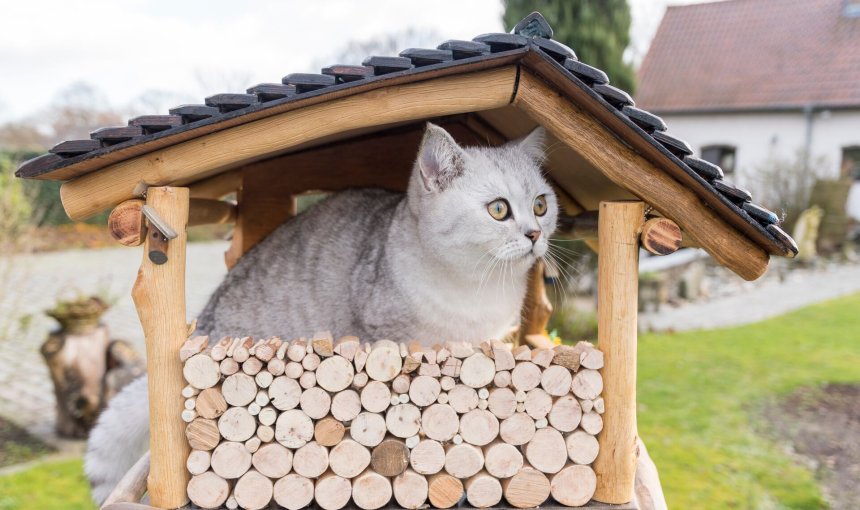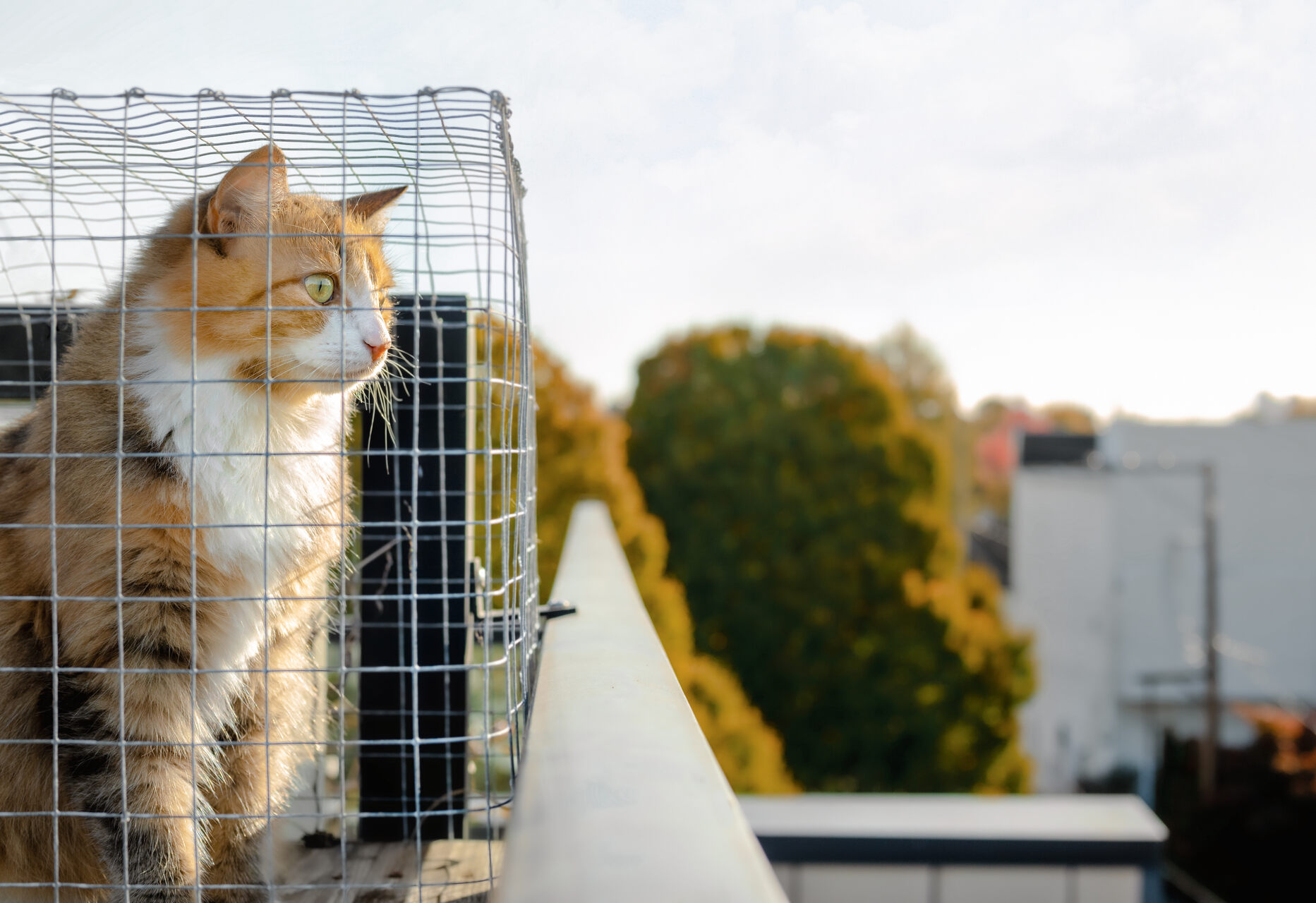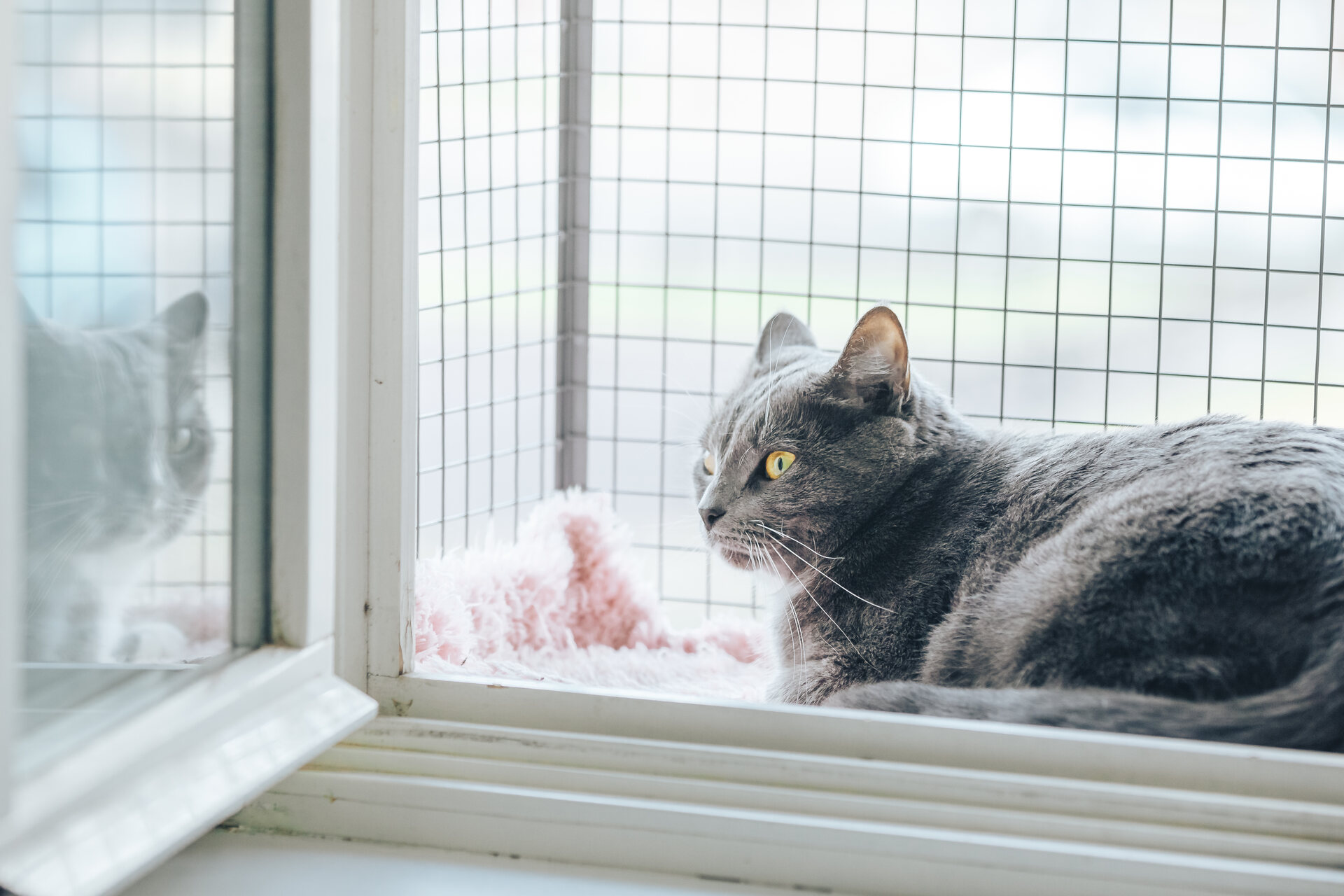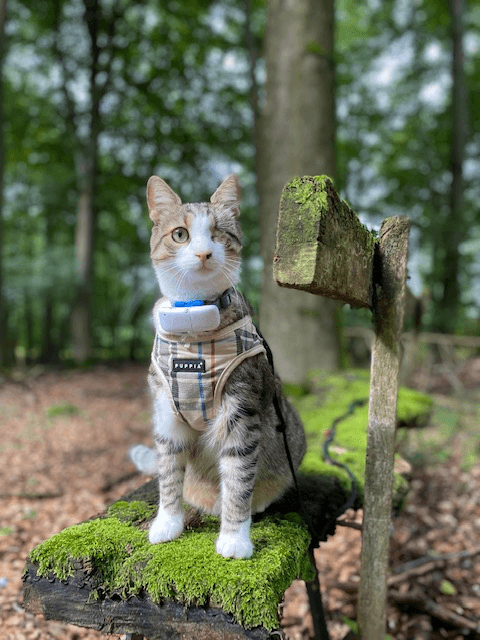How To Build Or DIY A Catio For Your Outdoorsy Buddy
Got an outdoor cat that's just itching to explore - or an indoor cat bored out of their minds at home? A catio - or a cat patio - can be a fun, safe solution offering them the supervised outdoor time they need to stay safe.

Is there a cat that doesn’t love snoozing in the sun, watching birds, and feeling the wind in their whiskers? Here’s a way for your indoor or outdoor cat to enjoy the enriching sights, sounds and smells of nature and still be protected. How? With an outdoor catio!
But with that said, you do also want to escape-proof your home and backyard. Especially if you’ve got a cat that’s intact, a skilled hunter, or in the habit of showing the neighborhood cats who’s boss. So here’s how to set up a safe, secure outdoor cat enclosure – without compromising on your cat’s safety.

Find out where your cat spends their time.
Read more- What is a catio?
- Simple catio ideas you can get started with right away
- How will my cat get in and out of the catio?
- What should I put in a catio?
- What’s the best location for a catio?
- Can I leave my cat in the catio at night?
- Buy or DIY: Pros and cons
- Will your cat ever want to leave the catio?
- Know everywhere your cat goes
What is a catio?
A catio is an outdoor cat enclosure or “cat patio.” You can build or buy one to provide a safe outdoor space for your cat. Catios let your cat safely stay outside and enjoy some time in nature. (While you have the peace of mind knowing they’re safe.)
By building an outdoor catio enclosure, you’re on your way to enriching the life of your indoor cat and keeping your outdoor cat safe and healthy. Importantly, it’s a way to provide them safe outdoors access without compromising on their safety.

Why build a catio?
Doesn’t matter if they’re an indoor or outdoor cat – all cats need some supervised outdoor time. (Especially if you don’t trust them to find their way back home by themselves.) Cooping them up at home makes them miss out on the fresh air, sunlight, nature, and the opportunity to keep their senses sharp. Besides making them likely to get bored, anxious, or stressed out.
⚠️ But even with all these perks, venturing outdoors opens up your cat for a whole bunch of dangers. Like from:
- Passing cars and cycles
- Open pools and other hard-to-escape spots, like the bottoms of cars
- Other pets, predators, and people – including pet thieves
- Poisonous plants
- And the seemingly never-ending list of foods off-limits to cats
A catio lets your buddy continue enjoying the open air – while staying protected. Plus, for indoor cats, it’s a great way to help them get a change of scenery from your home. (And not get bored and up to mischief instead!)
💡Plus, as an emergency measure – you could always try a cat GPS tracker for a change. Helping you track your cat in real-time or with an escape alert if they leave a “safe zone.”
But isn’t a catio confining my cat?
By building an outdoor catio instead of letting your cat roam freely outside, you’re not being cruel – you’re keeping your cat safe and healthy. And, you’ll have your fluffy friend around for many more years, since indoor cats live longer than outdoor cats on average1.
Besides, an outdoor catio is a great idea if you live in a:
- Small apartment and can’t take your indoor cat on supervised walks.
- Or a rural area where predators roam – and you don’t want to worry about your outdoor cat being injured or killed!
- Or an indoor space where you want to provide your cat some safe access to the sun and breeze
Simple catio ideas you can get started with right away
Depending on your time, budget, and resources, your catio could be simple – or pretty elaborate! You can build one on:
- Your balcony
- Your window
- Or even in your backyard – depending on where your cat (or cats) like to hang out most
You can DIY a catio ove a weekend using castoff or recycled materials. Else, you could invest in a deluxe catio setup – though these do tend to be on the pricier side. Here are a couple of options to get you started:
Window catio
A window catio hangs up against a first-floor window in your home.
- These can be small or extend all the way to the ground. (Keep in mind what excellent jumpers most cats are!)
- You can construct your own window catio from wood and wire, or hang a large dog crate up against the window.
- Be sure to add supports below so the structure is able to hold the weight of your cat without sagging.
The beauty of a window catio is that all you need to do is open your home’s window for your cat to enter their own personal outdoor room. Your pet can come back inside whenever they like.

Porch catio
Think of a porch catio as a miniature screened-in porch for your kitty.
- Construct it on your deck or patio, with the solid surface as the base.
- A porch catio can be any height. Make sure it includes an elevated perch or cat tree where your cat can get off the ground to survey their outdoor kingdom.
Balcony catio
If you live in an apartment, you can turn all or part of your balcony or fire escape into a catio.
- For a DIY option, zip-tie poultry fencing to the balcony’s railing, then add more poultry fencing on top to create an enclosure.
- Or, simply position a large dog crate on your balcony and place your kitty in it for long, lazy afternoon naps.
Be sure to leave space for yourself to enjoy the balcony or fire escape beside your cat. And of course, allow enough room to use the fire escape in an emergency.
Portable catios
A portable catio is a free-standing outdoor cat enclosure that sits in your yard and is not attached to your home. You can move it to different locations in your yard, or disassembled and taken with you if you move to a new home.
- You can choose a pop-up tent with screened sides, a mesh cat playpen, a wire enclosure that sets on your lawn, or a multi-level wood-frame catio.
- You can even buy a portable wood-frame enclosure kit online, which includes all the materials and hardware needed to assemble yourself.
- Else, you can also buy detailed DIY catio plans and purchase the materials, then build the structure in your yard.
Think about adding a vestibule with a two-door “airlock”-style entrance to create an escape-proof entry and exit point to your free-standing outdoor portable catio enclosure.
Outdoor cat tunnels
An outdoor cat tunnel can be freestanding or attached to your home or outdoor catio. They give your cat room to stroll around and patrol their territory.
- Soft mesh-sided cat tunnels are around 10 feet long and can be placed anywhere in your yard. Just flatten the mesh tunnel and put it away when kitty is done playing.
- Another option is to build a permanent outdoor cat tunnel from heavy wire, or create a wood frame and cover with sturdy window screening.
A screened-in porch
If you have an existing screened-in porch or three-season room attached to your house, you already have the perfect catio at your fingertips. (And your cat has probably already claimed it!)
If you don’t have a screened-in porch, it’s really a perfect way for you and your cat to enjoy ultimate outdoor living in total safety and comfort. While this is obviously an expensive undertaking, it’s worth considering to make the whole family happy.
How will my cat get in and out of the catio?
When building your catio, think about how your kitty will safely access this cat-friendly amenity. Do you want your cat to have 24/7 access, or do you want to monitor their comings and goings?
- Window access allows your cat an easy way to let your cat “outdoors” – without actually escaping. Just remember to close the window at night or when temperatures drop, so your cat stays indoors when it’s cold or dark outdoors.
- A doggy-door flap is a good idea if your catio enclosure is up against your house at ground-level. Just make sure to cover it at night to prevent your cat from sneaking out. Most doggy-doors have a cover that you can slide on at night, during severe weather, or whenever you want to keep your cat indoors.
- A combination cat tunnel and doggy-door flap is another fun option. A wood-and-wire outdoor cat tunnel can connect a free-standing portable catio to your home. Position one end the cat tunnel against a doggy-door flap on the outside wall of your home, and place the other against the free-standing outdoor catio enclosure. This allows your kitty to go outdoors whenever they choose.
What should I put in a catio?
This will depend on the size of your catio and whether your cat can enter and exit at will. Your catio can be simple, with just a rug and water bowl. But you could also include:
- Scratching posts and toys.
- Some shelves and a cat tree so kitty can perch up high.
- A little shelter box in case of rain.
- A comfy chair so you can enjoy the catio with your furry companion. (If it’s big enough.)
- A litter box.
- A planter of cat grass for munching is a nice touch for this cat house.
When designing your outdoor catio, remember that you’ll need to get into the catio, too – to fill water bowls, spruce up, clean the litter box, or deliver food. So make sure you can either reach into the catio enclosure or step inside through a large door.
What’s the best location for a catio?
Anyplace that your cat can be safely outdoors in a catio enclosure is a perfect location. If you have a few options on where to place your outdoor catio enclosure, consider these factors:
- Sunshine and shade: Cats love to bask in the sun, but they need shade for chilling out, too. So create a basking spot positioned to receive the morning sun, and build a little cubby or place a tarp over one corner of the catio’s roof to create a shady nook.
- The view: Any view of the outdoors will give your cat lots to look at all day long – birds, leaves blowing in the wind, little bugs flying by, or kids outside playing. If you can position your outdoor catio to maximize the view, your cat will appreciate it.
- Not too far from the house: You are your cat’s favorite human, so place your catio where you and your cat can interact during the day. If it’s too far from the house, you may not be able to keep an eye on your kitty.
Can I leave my cat in the catio at night?
Giving your cat overnight access to an outdoor catio depends on the catio’s location and your comfort level.
- If your catio is accessed through a doggy-door, decide if you want the doggy-door left open all night.
- Your cat may want to come back inside because of bad weather (or a sudden desire to sleep right next to your head).
The safest option is to bring your cat indoors at night. Many predators and outdoor cats roam at night, and your cat could become frightened or hassled by them while alone in the outdoor catio enclosure.
Likewise, noises like fireworks can startle your cat and make them afraid of going back outdoors. And if unexpected storms roll in, you don’t want your kitty to face that alone.
Buy or DIY: Pros and cons
- DIY Catio – Pros: On the plus side, you can customize a DIY catio enclosure to meet your cat’s specific needs. Also, you can securely attach the catio to your window, patio, or other structure by building it yourself. A DIY catio will probably cost less than a ready-made catio or catio kit, and detailed DIY catio plans can be downloaded for free or purchased inexpensively online.
- DIY Catio – Cons: The downside of a DIY catio is that…well, you have to build it. You’ll need at least a tiny bit of construction know-how and some basic tools. If this is not you, enlist the help of a handy friend! A DIY project can also take longer and require more planning than buying a catio kit.
- Buy a Catio – Pros: Buying a catio enclosure kit means that all the lumber, screening, and hardware is included. You’ll still need a few basic tools and be able to understand the instructions, but you can probably complete the project in half a day.
- Buy a Catio – Cons: You’ll most likely spend more on an outdoor catio kit than building it yourself. Also, you have limited options for customizing a catio kit.
How much do catios cost?
Pre-assembled outdoor catios or cat patio kits can cost anywhere from $200 to thousands of dollars.
On the other hand, you can DIY a catio enclosure for far less. You may even be able to repurpose scrap wood, screening, or an old dog crate and build your DIY catio at no cost.
What do I need for a DIY catio?
To build your own DIY catio, you’ll need:
- A plan: download free catio plans or purchase one online, or sketch out your idea in advance.
- Tools: A measuring tape, saw, hammer, drill, wire cutters, and screws.
- Materials: Wood boards of various sizes, depending on the dimensions of your catio; and wire (such as poultry fencing) or sturdy screening. You’ll need to calculate how much you need depending on the catio’s size (hence the need to sketch out a plan in advance!).
Depending on your skills and complexity of the project, you might spend a half-day or an entire weekend building your DIY catio. But your feline friend will thank you.
Will your cat ever want to leave the catio?
Maybe not! An outdoor catio enclosure, whether big or small, simple or elaborate, may become your cat’s new favorite place. In fact, you may have a hard time getting your furry companion to leave the catio!
Though we do understand if you’re worried – which is where it makes sense to plan ahead for an emergency. Anyone with cats knows how they can wriggle out of Fort Knox, if they really put their minds to it. Let alone a catio within sight of the local squirrel population, passing birds, that purr-fect neighboring cat, or someone invading your cat’s territory.
All of which can trigger an escape attempt – and now you’re dealing with a missing cat situation.
💡Which is where a GPS tracker can be an important emergency measure.

😺 With your trusty Tractive GPS strapped to your cat’s collar, you can now track them:
- In real-time,
- Over an unlimited range,
- Right across their territory,
- And even while on vacation – or 175 countries if you’re on a Premium subscription
All with just a glance at your phone.

“Anyone with cats knows how slick they are…even if your cat is an indoor cat, they will eventually find a way out.
My cat is indoor and outdoor, and I will never again have a cat without a Tractive! First, it’s fascinating seeing where they go, their favorite spots, and the territory they establish.
Second, when she has been out too long and I start to worry, I know right where she is and I go get her! I would recommend this highly for both cats and dogs!“
– Traci, US (Source: Trustpilot)

Know everywhere your cat goes
See where they are in real-time, no matter how far they go. Get alerts if they roam too far home. Find out where they’ve been and discover their favorite spots. Let others track with you.
Need some more inspiration for your cat patio? Then checkout these cute cat-ios enjoying their outdoor abode!
And if you’ve liked this post, share it with a friend or a loved one – and let’s help build a safer, kinder world for our furry friends together.




